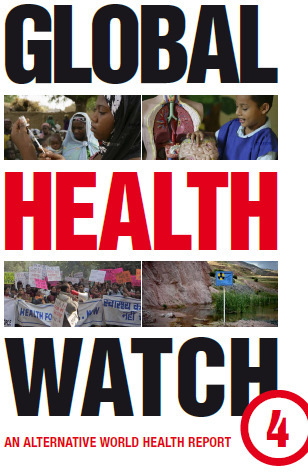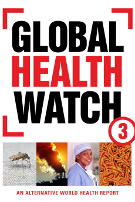Key documents
Draft action plan for the prevention and control of noncommunicable diseases 2013–2020 (EB132/7)
Secretariat note
In response to subparagraphs 2(4) and 2(6) of resolution EB130.R7 and subparagraph 3(4) of resolution WHA64.11, the Secretariat has prepared a draft action plan (EB132/7) for the prevention and control of noncommunicable diseases for 2013–2020 for consideration by Member States. The draft action plan was developed taking into account the outcomes of informal and formal consultations with Member States and United Nations bodies which took place in August 2012 and November 2012, as well as the views received from relevant nongovernmental organizations and selected private sector entities during a web-based consultation. The Board is invited to note the work under way to develop the action plan, and to provide guidance on a number of strategic issues listed as decision points.
PHM comment pre-EB
We summarise below some key issues to seek that require attention by member states:
Lack of a Social Determinants of Health approach: while the document recognizes – at least generally – that the factors that shape the NCD epidemic lie outside the reach of health policy and that most health gains in terms of prevention will be made by influencing domains such as social position, income, education, occupation, gender and ethnicity, there is weak application of these principles in the action plan. In particular, the action plan adopts a narrow “risk factors” approach based on interventions aimed to change individual behaviours that might prevent the adoption of broader measures aimed at modifying the social context. NCDs are viewed as problems mainly resulting from harmful individual behaviours and lifestyle choices, often linked to victim-blaming, while the influence of socioeconomic circumstances on risk and vulnerability to NCDs and the impact of health-damaging policies are underestimated. This vision is mirrored in the comprehensive global monitoring framework, where the SDH are only weakly embedded. The document makes a little mention of the issues of distribution of resources and money, trade and industry practices.
Vertical Approach: following the path defined in the previous global strategy (2008-2013 Action Plan for the Global Strategy Global Strategy for the Prevention and Control of Non-communicable Diseases), the action plan focuses on four disease, namely CVD, diabetes, chronic respiratory diseases, and cancer. Even though importance of an integration of non-communicable disease programmes is mentioned in the final paragraphs, there is a huge risk that the narrow focus on specific diseases would contribute to a vertical approach rather than a more broadly integrated primary care approach. The strategy create an artificial fragmentation between chronic conditions. This is demonstrated by the choice of addressing NCDs, mental health and visual impairment through different action plans (listed as agenda items 6.3 and 6.4). We urge Member States to propose an integration of all action plans concerning the prevention and control of NCDs.
Boost to partnerships: the Action Plan explicitly calls for the involvement of the private sector as one of the international 'partners'. While the tobacco industry is explicitly excluded and there is a growing awareness - as Dr Chan highlighted - that “many of the threats to health that contribute to NCDs come from corporations”, there is no mention of an effective management of potential conflict of interests arising from the engagement with corporations representing agribusiness, beverage and pharmaceutical industries. In particular we are concerned about the influence pharmaceutical industries might have in shaping the research agenda and the public health strategies. In this regard it is fundamental for Member State to carry out independent analyses and evaluations of the efficacy, safety, cost-effectiveness and feasibility of public health measures – including pharmaceutical interventions - in their own contexts.
The proposed action plan bypasses and undermines the recommendation of the CEWG on R&D: financing and coordination. The CEWG linked the key elements of priorities, financing, coordination and access into a concerted global framework for health R&D. The action plan should explicitly include work to form a global convention on health R&D to address access to essential health technologies for non-communicable diseases particularly in developing countries.
The action plan completely ignores many operative sections of the
Political declaration of the High-level Meeting of the General Assembly on the Prevention and Control of Non-communicable Diseases. For example, the UN declaration recommended in the context of access to medicines and technologies, “Promote access to comprehensive and cost-effective prevention, treatment and care for the integrated management of non-communicable diseases, including, inter alia, increased access to affordable, safe, effective and quality medicines and diagnostics and other technologies, including through the full use of trade-related aspects of intellectual property rights (TRIPS) flexibilities;”. The action plan is silent on this aspect.
Further para 52 of the UN declaration urges “relevant international organizations to continue to provide technical assistance and capacity-building to developing countries, especially to the least developed countries, in the areas of non-communicable disease prevention and control and promotion of access to medicines for all, including through the full use of trade-related aspects of intellectual property rights flexibilities and provisions..” However the action plan is silent on the role of WHO in providing technical assistance to use of TRIPS flexibilities.
Report of discussion
Member States sought further work on the action plan before it arises at 66 WHA. Member States also sought integration of existing WHO strategies on tobacco, alcohol, healthy diet and physical exercise to be linked to the NCD action plan, as well as mental health. Norway did not agree with separation on action plan for NCDs and mental health while Myanmar requested collaboration between all technical units working on NCDs work together to avoid duplication.
The EU sought concrete process indicators and not just outcomes.
Member States requested a regional dimension to the action plan and for WHO to include the existing regional strategies on NCDs on the website to compliment. They emphasised the role of country offices. Some of them also stressed a “health in all policies” approach.
Members of the EMRO asked to revise the action plan for clarity, stating that the WHO actions were too broad and that it is not clear what needs to be done to strengthen country capacity. Actions should take into account country specificities, be focused and take into account regions.
AFRO stressed the need for strengthening health systems to drive social determinants of health and risk factors.
USA said that hearing from the NGO sector before Member States was useful and that this kind of process could be used in the future. Australia stated that indigenous people, children, maternal and gender issues would give the document more richness.
Mongolia requested an international convention on alcohol control while Cuba proposed to use the same references in this document for alcohol, including measures to have an impact on sensitisation, awareness raising, community action.
Thailand sought a separate section on implementation mechanisms. The action plan should protect and safeguard public health from any conflict of interests. They noted the impact of bilateral and multilateral trade agreements for countries. The action plan should support Member States to ensure access to medicines and technologies, crucial for functioning health systems and some are unaffordable in low income countries. TRIPS flexibilities should be better reflected in the draft action plan.
The International Labour Office urged for consideration of a plan for workers and occupational diseases. NGOs advocated for inclusion of oral health, as well as a people and patient centred approach.
The Director General, reflecting on comments by Mongolia in 6.1 and Cuba in 6.2 for an Framework Convention on Tobacco Control type framework on alcohol, stated that the only consensus at the moment is on the harmful use of alcohol. “I need to hear member states - do you agree or not on a convention? The secretariat is here and will be guided by you”.
The decision was to hold informal discussions in March with NGOs and the private sector with a plan to go ahead with a revised action plan to the 66th WHA. The Assistant DG asked member states to set and clarify the role of NGOs and the private sector.
The NCD Alliance has also provided an update on the progress on NCDs at the 132nd EB on the first day here:
http://us4.campaign-archive1.com/?u=f8751cb14c745b632f0e2871c&id=a8f0325d17&e=020e0fbf35
PHM Statement on noncommunicable diseases (NCDs)
PHM comment post-EB
Other reports and commentary




